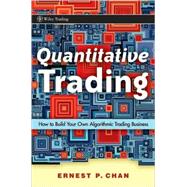
Ernest P. Chan, PhD, is a quantitative trader and consultant who advises clients on how to implement automated statistical trading strategies. He has worked as a quantitative researcher and trader in various investment banks including Morgan Stanley and Credit Suisse, as well as hedge funds such as Mapleridge Capital, Millennium Partners, and MANE Fund Management. Dr. Chan earned a PhD in physics from Cornell University.
| Preface | p. xi |
| Acknowledgments | p. xvii |
| The Whats, Whos, and Whys of Quantitative Trading | p. 1 |
| Who Can Become a Quantitative Trader? | p. 2 |
| The Business Case for Quantitative Trading | p. 4 |
| Scalability | p. 5 |
| Demand on Time | p. 5 |
| The Nonnecessity of Marketing | p. 7 |
| The Way Forward | p. 8 |
| Fishing for Ideas | p. 9 |
| How to Identify a Strategy That Suits You | p. 12 |
| Your Working Hours | p. 12 |
| Your Programming Skills | p. 13 |
| Your Trading Capital | p. 13 |
| Your Goal | p. 16 |
| A Taste for Plausible Strategies and Their Pitfalls | p. 17 |
| How Does It Compare with a Benchmark and How Consistent Are Its Returns? | p. 18 |
| How Deep and Long Is the Drawdown? | p. 21 |
| How Will Transaction Costs Affect the Strategy? | p. 22 |
| Does the Data Suffer from Survivorship Bias? | p. 24 |
| How Did the Performance of the Strategy Change over the Years? | p. 24 |
| Does the Strategy Suffer from Data-Snooping Bias? | p. 25 |
| Does the Strategy "Fly under the Radar" of Institutional Money Managers? | p. 27 |
| Summary | p. 28 |
| Backtesting | p. 31 |
| Common Backtesting Platforms | p. 32 |
| Excel | p. 32 |
| MATLAB | p. 32 |
| TradeStation | p. 32 |
| High-End Backtesting Platforms | p. 35 |
| Finding and Using Historical Databases | p. 36 |
| Are the Data Split and Dividend Adjusted? | p. 36 |
| Are the Data Survivorship Bias Free? | p. 40 |
| Does Your Strategy Use High and Low Data? | p. 42 |
| Performance Measurement | p. 43 |
| Common Backtesting Pitfalls to Avoid | p. 50 |
| Look-Ahead Bias | p. 51 |
| Data-Snooping Bias | p. 52 |
| Transaction Costs | p. 60 |
| Strategy Refinement | p. 65 |
| Summary | p. 66 |
| Setting Up Your Business | p. 69 |
| Business Structure: Retail or Proprietary? | p. 69 |
| Choosing a Brokerage or Proprietary Trading Firm | p. 71 |
| Physical Infrastructure | p. 75 |
| Summary | p. 77 |
| Execution Systems | p. 79 |
| What an Automated Trading System Can Do for You | p. 79 |
| Building a Semiautomated Trading System | p. 81 |
| Building a Fully Automated Trading System | p. 84 |
| Minimizing Transaction Costs | p. 87 |
| Testing Your System by Paper Trading | p. 89 |
| Why Does Actual Performance Diverge from Expectations? | p. 90 |
| Summary | p. 92 |
| Money and Risk Management | p. 95 |
| Optimal Capital Allocation and Leverage | p. 95 |
| Risk Management | p. 103 |
| Psychological Preparedness | p. 108 |
| Summary | p. 111 |
| A Simple Derivation of the Kelly Formula when Return Distribution Is Gaussian | p. 112 |
| Special Topics in Quantitative Trading | p. 115 |
| Mean-Reverting versus Momentum Strategies | p. 116 |
| Regime Switching | p. 119 |
| Stationarity and Cointegration | p. 126 |
| Factor Models | p. 133 |
| What Is Your Exit Strategy? | p. 140 |
| Seasonal Trading Strategies | p. 143 |
| High-Frequency Trading Strategies | p. 151 |
| Is It Better to Have a High-Leverage versus a High-Beta Portfolio? | p. 153 |
| Summary | p. 154 |
| Conclusion: Can Independent Traders Succeed? | p. 157 |
| Next Steps | p. 161 |
| A Quick Survey of MATLAB | p. 163 |
| Bibliography | p. 169 |
| About the Author | p. 173 |
| Index | p. 175 |
| Table of Contents provided by Ingram. All Rights Reserved. |
The New copy of this book will include any supplemental materials advertised. Please check the title of the book to determine if it should include any access cards, study guides, lab manuals, CDs, etc.
The Used, Rental and eBook copies of this book are not guaranteed to include any supplemental materials. Typically, only the book itself is included. This is true even if the title states it includes any access cards, study guides, lab manuals, CDs, etc.